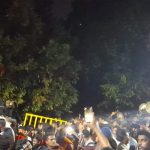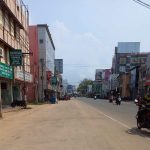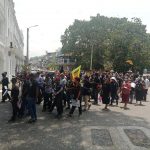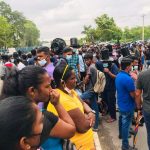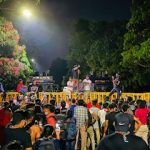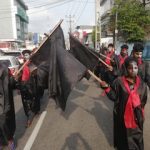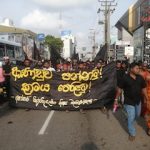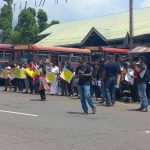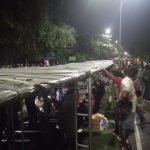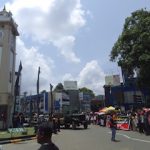![1st_Day_At_the_Parliamant_Junction[1]](https://www.socialistworld.net/wp-content/uploads/2022/05/1st_Day_At_the_Parliamant_Junction1-678x381.jpg)
Some Pictures from of Hartal Day
On Friday 6th of May, 2022, the sun rose on the island nation Sri Lanka just as on any other day. But it was not an ordinary day. Hundreds of thousands of people, together with all the trade unions, shop owners, small traders and businesses were ready to carry out a nationwide ‘hartal’.
Life has become unbearable without food, electricity and gas. There is no foreign currency to import vital medicines, foodstuffs, fertilizer and fuel. Prices have rocketed beyond imaginable levels.
In every town, from east to west and north to south, most businesses were closed and black flags were raised. Tens of thousands of people belonging to every social class, race and religion all together eagerly gathered in town squares, most of them wearing black clothes and some carrying black flags, joined the call demanding that the current president, Gotabaya Rajapaksa, resign.
This was the first hartal event in Sri Lanka since the 1953 hartal, where people rose against the then prime minister Dudley Senanayake for raising the price of rice from 25 cents to 70 cents. But instead of just the northern and coastal areas that joined the hartal in 1953, the entire island joined this time.
None of the conventional political parties in the opposition, Samagi Jana Balawegaya and Tamil National Alliance, participated in the hartal as political parties, but the Janatha Vimukthi Peramuna participated and organized rallies and protests in support of the hartal.
Everywhere
Every town and industry was well organized. Both private and government sector banks were closed and all the workers came onto the streets to protest. No trains were running on that day. All the schools and universities, including the private sector, were closed. The central bus stand of Colombo was empty and youths were playing cricket there. At several junctions, people cooked a Mala Batha (funeral rice), a traditional meal some Sri Lankans cook after a funeral declaring this action was the funeral of the current government.
Major protests were organized at Katunayake, Biyagama, Mathugama and Koggala Export Processing Zones by the factory workers. Some cities like Anuradhapura had distributed maps among the people notifying them where the protests were held. Jaffna town was closed entirely. Batticaloa, a coastal town in the east with a majority of a Muslim population, had a massive demonstration. Passara town in the Uwa province also had a significant demonstration. In Matara town, the JVP organized a colossal protest and a rally.
A large crowd gathered in the capital city of the central province, Kandy and marched around the city, chanting slogans while carrying black flags. The occupation site in Kurunegala – ‘Gota Go Gama (Home)’ – held another demonstration with massive public support. Gampaha, Kiribathgoda, Rathnapura and Galle also had large rallies. A considerable number of parents brought their children to the protesting sites – a new development in Sri Lanka. On top of all this, small-scale demonstrations were held at many road junctions around the country.
Road to Parliament
The most potent and significant demonstration was held at the main entry road to the parliament. It was organized by the youths of Galleface Gota Go Gama in collaboration with the Inter-University Student Federation and Inter-University Bhikku Federation (the university students and Bhikkus union linked with the Front Line Socialist Party).
On the previous day, the IUSF and IUBF came to the parliament entry road demanding the current government and president Gotabaya Rajapaksha resign. The government was ready for them with newly built permanent barriers using GI pipes, barricades and water cannons. When they were protesting peacefully, police and the paramilitary STF unit used water cannons and tear gas on them. They used N-500 gas grenades that are only used in hostage rescue operations.
The social media was very active giving updates on everything happening in the area and thousands of people gathered to give the students support. These were the same people who, less than a year ago, criticized the student movement for fighting for their rights and protesting. There has been a paradigm shift and now a majority of the people accept them as heroes and consider them as flagbearers of the peoples’ struggle.
A large number of youths came from the Galleface Gota Go Gama protest site with supplies. IUSF, IUBF, and youths from Gota Go Gama declared they would occupy the area and named the place “Horu Go Gama,” which means ‘Thieves Go Village’. They were prepared and they brought wrenches to dismantle the permanent barricades police had built. They used those pipes to create a stage and shelters for them to get protected from the rain.
Activists notified people, using their social media accounts, that they require water, food and electricity. Within two hours, people came there with water bottles, food, tents and a generator. Six music bands also came to entertain the people who gathered there. They established a formidable protest site to demonstrate on the day of the hartal.
Next day
On the following day, students and youths, altogether with people who gathered at that site, continued to start the protest. In the evening, police launched another wave of a teargas and water cannon attack, destroying all the food and water that people had donated to the protesters. In the evening the Speaker of the Parliament decided to adjourn the parliament until 17th May.
With this decision, youths and the IUSF decided to abandon the occupation since there is no point in occupying a space in front of an empty building. At the same time, they received news that there was a plan to remove the Gota Go Gama at the main protest site near the Presidential Secretariat, on that night.
Considering all the information, the organisers declared they would leave the place and come back on the 17 May. But a large number of people gathered there were against that decision. They continued to protest. Police launched another massive tear gas and water cannon attack on the protesters, including children and brutally assaulted some of the protesters.
At around 10.00 pm, President Gotabaya Rajapaksa declared a nationwide state of emergency. Everyone at Gota Go Gama suspected that the government might try to remove the settlement under the emergency regulations and a large number of protesters spent the night there.
The way forward
The mighty struggle in Sri Lanka goes on. The United Socialist Party is bringing out a new issue of its paper urging workers and youth to organize the struggle through democratically elected workplace and area committees and for a Democratic Assembly to work out how to replace the ruling family elite with their own government.
For an end to poverty, dictatorship and private ownership of land, industry and banks! For a government of the workers and poor that stands for a confederation of socialist states in Asia and world-wiide!
Special financial appeal to all readers of socialistworld.net |
Support building alternative socialist media Socialistworld.net provides a unique analysis and perspective of world events. Socialistworld.net also plays a crucial role in building the struggle for socialism across all continents. Capitalism has failed! Assist us to build the fight-back and prepare for the stormy period of class struggles ahead. Please make a donation to help us reach more readers and to widen our socialist campaigning work across the world. |
Donate via Paypal |
| M | T | W | T | F | S | S |
|---|---|---|---|---|---|---|
| 1 | ||||||
| 2 | 3 | 4 | 5 | 6 | 7 | 8 |
| 9 | 10 | 11 | 12 | 13 | 14 | 15 |
| 16 | 17 | 18 | 19 | 20 | 21 | 22 |
| 23 | 24 | 25 | 26 | 27 | 28 | 29 |
| 30 | 31 | |||||

